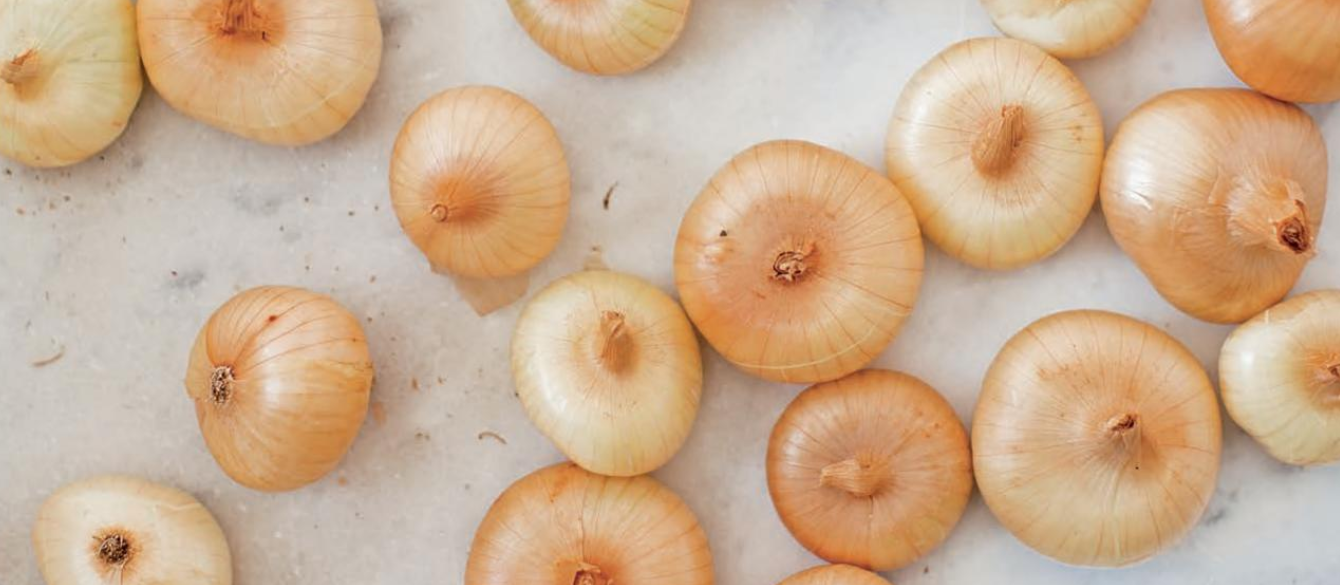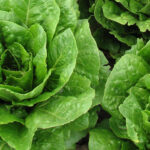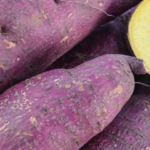Cipollini onions are petite, saucer-shaped, flat bulbed Italian onions which have a uniform attractive appearance. The onions are of a mini size of between 1.5 inches to 2 inches in diameter. Cipollinis are also known as Italian onions or little onions in Italian. The onions have a spicy pungent flavor when raw and sweet flavor when cooked. Cipollinis are used raw or cooked in a variety of culinary dishes including salads, grills and roasts. They are a fairly easy to grow onion crop for many home growers.
Table of Contents
What is Cipollini Onion?
Cipollini onions are niche market alliums which are a legitimate member of the Allium cepa species and Amaryllidaceous family. Common family members are chives, shallots, scallions, leeks and garlic. The onions are sometimes substituted with Borettana onions as the two have very close lineage.
Cipollinis are characteristically miniature in size, growing to only 2 inches or 5cm in diameter compared to regular onions which can grow to as much as 4.5 inches or 11cm in diameter. They weigh as little as 1 Oz. to 3 Oz. or 28 grams to 85 grams. Due to their small size, Italian onions are often used in numbers in culinary applications.
Descriptively, apart from their small size, Italian onions are famously saucer-shaped or disc-shaped bulbs. They are also sometimes described as coin-shaped onions. This relates to their flat bottom and flat top shape. Furthermore, Cipollini onions have peppery skin which adheres unyieldingly to the flesh.
This tightly worn skin is a protective layer to the onion itself which when cut or abraded triggers rapid fruit deterioration at the exposure of the onion flesh to air. Due to the tightly adhering skin, there are devised methods to easily peel the skin off the onion (see recipes section). Even so, it is possible to find pre-peeled fresh Cipollinis on the market.
When in the ground during cultivation, Cipollinis do not show any bulbs above the ground as occurs with some regular globe-shaped onions. Cipollini onions are easy and fast to harvest. Growers can pull as many as 8 plants by the leaves out of the ground at a time (see growing section). The onions possess excellent uniformity in shape and size which makes them aesthetically appealing when prepared for the fresh market.
As far as culinary aspects are concerned, Cipollinis are very flavorful onions when cooked. Some of their common recipe applications are roasting and caramelization in butter or oil. When cooked in this manner, the onions turn a sweet flavor and become tender as if they are melting. The higher residual sugar content in the onion compared to other onions result in increased sweetness when cooked. However, raw Cipollini onions have a semi-sweet spicy pungent flavor but lack any bitterness.
Basic Onion Kitchen Utensils
Onions regardless of type are not always the easiest to handle for a variety of reasons including their pungent smell which also causes onion tears and burning eyes. Furthermore, for best results when cooking, onions must have been carefully stored prior. The following are some handy kitchen utensils to consider when working with onions including the little Italian onions.
- Onion chopper
- Onion holder
- Mandoline for slicing onion
- Onion goggles
- Onion saver
- Onion storage bin
- Onion sacks
Cipollini Onions Origins
The Cipollini onion is native to Italy where they were grown in a small township of Boretto in the 15th Century. The onions subsequently found their way to North America by Italian immigrants. During the 1990s the onions started to appear in Italian restaurants in the United States. This may have contributed to growing interest.
Today, Cipollinis are widely available as specialty produce in North America and also grown in home gardens (see growing section). They are also found in other parts of the world with similar growing conditions as those found in Boretto and surrounding areas where the onion was first cultivated.
Cipollini Onion Varieties
Although white Cipollini onion appears to be the most frequently talked about and presented, there are other Cipollinis namely red and yellow ones. This color difference is mostly skin deep as the onions have a consistent white flesh across the different colors save for the red variety which may have a red deep in the onion rings.
One of the most grown Cipollini varieties is the Gold Coin. This is a Cipollini onion with golden colored peppery skin. This onion has the typical flat saucer-shape associated with Italian onions. In the United States this variety does very well in the southern States and requires at least 80 days to reach maturity.
Another Cipollini variety is the Red Marble. This is an F1 hybrid Cipollini onion that matures in 95 days. It is a hard onion which matures with what can be described as a stony polished red skin. This onion, like other Cipollini onions, can be manipulated to mature as red baby pearl onions by simply closely spacing it during cultivation.
When grown as baby pearl onion, the Red Marble will have a diameter of between 1 and 2 inches or 2.5 to 5cm. Increasing spacing will produce the typical Cipollini onion. The Red Marble Cipollini variety has one more desirable advantage which is its ability to store well.
Any consideration of Cipollini onion varieties would hardly be complete without regarding the Bianca Di Maggio variety. This is a white Cipollini variety which grows as wide as 2 to 3 inches or 5cm to 7.6cm in diameter and has a height of 1.5 inches or 38mm.
Unlike the Red Marble which is a hybrid variety, Bianca Di Maggio is an open pollinated Cipollini which matures in about 80 days. It has a mild flavor and has a particular disadvantage which is limited storage.
Cipollini Onions Nutrition
Cipollini onions carry some decent level of nutritional value. As a matter of fact, their nutritional profile is consistent with a variety of other onions of the Allium cepa species. One notable aspect about Cipollinis is their low calorie count.
For example, 80 grams of raw Cipollini onion, which is roughly the biggest onion size of the cultivar, translates to about 35 calories. This same quantity has about 8 grams in carbs and 1 gram in protein.
Like most onions, Cipollinis are a reasonable source of fiber at about 4% of daily intake in 80 grams of raw onion. They also offer 2% of calcium. A freshly harvested Cipollini onion consists roughly of 90% water, 9% carbs and 1% fiber. This is one of the reasons Cipollini onions are juicy. In addition, Cipollinis are sodium free and cholesterol free. They are also a good source of vitamin C.
Red Cipollinis in particular, such as the earlier discussed Red Marble variety, contain anthocyanins, a bio-chemical compound which gives the onion its red color but also is a highly health beneficial antioxidant. Anthocyanins are also found in purple lettuce, and black tomatoes, for example.
Scientific studies have shown functional health benefits associated with fruits and vegetables containing anthocyanins. These benefits include cancer prevention, anti-inflammation and blood pressure control among others as expounded in this article which appeared in 2004 in the Journal of Biomedicine and Biotechnology.
Furthermore, yellow Cipollini onions offer other types of human health beneficial antioxidants. According to Healthline, yellow onions have as much as 11 times more antioxidants than white onions. Overall, the nutritional value associated with Cipollinis makes them more valuable beyond being just trendy gourmet specialty onions.
Cipollini Onions vs Sweet Onions
A comparison of Cipollini onions and sweet onions shows that Cipollinis are a type of sweet onion, albeit with a caveat. As earlier mentioned, the sweetness of Cipollinis is coaxed through cooking. In its raw state the onion only has a little sweetness and more pungency as any ordinary onion.
Real sweet onions such as the Maui, Texas Legend, Walla Walla and Vidalia (see next section) are not pungent. They are so sweet and can be eaten fresh and raw immediately after picking as one would eat an apple.
Furthermore, another point of difference is, when juxtaposed, Cipollini onions are much smaller in size as compared to typical sweet onions. For example, Maui onions look similar in size to regular pungent onions. Texas Legend grows as big as a baseball and is well rounded and not flattened as the Cipollini.
Cipollinis and regular sweet onions also tend to be used differently in culinary dishes. For example, whereas Cipollinis are often roasted whole in clusters due to their small size, sweet onions, on the other hand, are used in singles and often sliced up due to their regular or big onion size.
In addition, sweet onions such as Maui are generally not considered suitable substitutes for Cipollini onion when cooking. Instead, shallots (see below) are a more suitable substitute.
Finally, Cipollinis and sweet onions are raised differently. The sweetness of sweet onions is attributed to growing conditions with little to no sulfur content. This takes away the sharp taste and tear causing odor associated with regular onions.
For this reason, sweet onions such as Maui and Vidalia can only be cultivated in certain locations where the soils are low in sulfur. As such Maui onions are grown in Maui Hawaii and Vidalia in Georgia, United States. Overall, although these differences exist between these onions, what is in common is that Cipollini onions and sweet onions are all specialty onions.
Cipollini Onions vs Vidalia
Compared to Cipollini onion, Vidalia is a much sweeter onion as earlier stated. It is even claimed to be the “world’s sweetest onion” in some circles. Vidalia onion is one of the three well known sweet onions that are sweet even when raw.
This is unlike Cipollini which is essentially sweet when cooked. Vidalia is very sweet, is not hot and has no pungent. It is a typical example of a sweet onion that can be eaten raw and enjoyed just as an apple straight from the field.
Side-by-side with Cipollini onions, the smallest Vidalia onion can be as small as Cipollini onions at 1 to 2 1/4 inches wide. A medium size Vidalia is 2 to 3 inches while the jumbo size is over 3 inches in diameter according to Morris Farms which grows Vidalia onions in Georgia.
Furthermore, there is some more resemblance between the two onions. While Cipollini has the famous disc-shape with a flat top and bottom, Vidalia also has a flat looking top and bottom shape, with the middle slightly bulged out.
The flat shape of the Vidalia also depends on the stage at which the onion has been harvested. We observe that in some cases Vidalia looks similar to ordinary onion particularly when harvested early.
A comparison of recipe uses between Cipollini onions and Vidalia onions shows that the two onions have some shared applications while other uses are more desirable for the Vidalia.
For example, both onions can be used in recipe preparations involving grilling, sautéing and cooking. On the other hand, Vidalia onions are better suited in raw preparations such as salads, sandwiches and burgers. This is because Vidalias taste better when raw compared to Cipollinis.
Cipollini Onions vs Pearl Onions
Another interesting comparison to make is between Cipollinis and pearl onions. It is sometimes asked, are Cipollini onions the same as pearl onions? Juxtaposed, it is apparent by physical appearance that normal Cipollini onions are not the same as pearl onions. A key distinction is in shape and size. Pearl onions are rounded with rather oblong ends compared to flattened Cipollini onions.
Furthermore, pearl onions are generally much smaller in size than Cipollinis at between 1 and 1.5 inches in diameter depending on variety. The bottom line is that Cipollinis can be grown as pearl onions, but not all Cipollinis are pearl onions. It is the size of the onion that determines whether or not it is a pearl onion.
Cipollinis raised as pearl onions are densely spaced when in cultivation, reducing their proportion to pearl size. When they are harvested they are offered as Cipollini pearl onions.
Other physical similarities between the two are that pearl onions have skin that tightly adheres to the flesh of the onion. For this reason, just like Cipollinis, they are also notoriously difficult to peel. Both onions are thus best peeled using the blanching method.
Pertaining taste and flavor, pearl onions share further similarities with Cipollinis. Pearl onions are also juicy, have a mild flavor, some sweetness and slightly less pungency than normal size white onions.
On the whole, pearl onions can be interchangeably used with Cipollini onions in a variety of culinary preparations. Just like Cipollinis, pearl onions are used whole, can be grilled, roasted, caramelized, pickled and also used in cooking.
Cipollini Onions vs Shallots
One more comparison to make is between Cipollinis and shallots. Shallots are bulb small onions which grow in clusters. They have the appearance of a cross between garlic and onion. This physical appearance is one immediate and obvious contrasting factor from Cipollini onions.
However, when contrasted for taste and flavor, Cipollinis and shallots have some things in common. Shallots are a good substitute for Cipollinis. They have a sweetness in their flavor and easily break down in the same fashion as Cipollinis when cooked.
Shallots also have a strong onion flavor just like Cipollinis. Certain culinary applications of shallots are similar to that of Cipollinis. For example, shallots can also be grilled, sautéed, braised, roasted and pickled just like little onions.
Cipollini Onion Uses
There is a wide range of Cipollini onion uses available to home cooks. It can be said with confidence that it is virtually impossible to run out of things to do with these tasty small onions. If all originality fails, there is always room to go after recipes that use shallots and simply replace those with Cipollinis. That is how hard it is to reach a dead-end on what to do with these famous little onions.
Nonetheless, the following is our compiled list of the recipe things that could be done using Cipollinis.
- Salads
- Stews
- Soups
- Sauces
- Roasts
- Grills
- Cooking
- Kebabs
- Skewering
- Martinis/cocktails
- Pickled condiments
- Pasta toppings
- Pizza toppings
- Caramelization
- Casseroles
- Sandwiches
- Scrambled eggs
- Sautéed onions
Cipollini Onion Recipes
As earlier mentioned, Cipollinis can be used in a variety of culinary recipe applications raw or cooked. The following are some succulent recipe ideas to try out that involve the onion.
Roasted Cipollini Onions Recipe
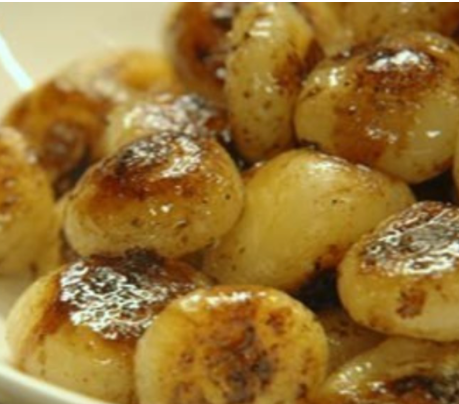
This recipe produces very tasty caramelized Cipollinis. If Cipollini onions are not available right away, you could still make this dish using pearl onions. The roasting of the Cipollinis in the oven nicely coaxes their sweet flavor. The recipe will need approximately 50 onions which are peeled and roasted whole.
Ingredients that go into the preparation excluding the little onions are dairy butter or unsalted butter, kosher salt, extra virgin olive oil and freshly ground black pepper. The recipe makes for up to 8 and takes 1 hour to complete. View Recipe.
Roasted Cipollini Onion Torta Recipe
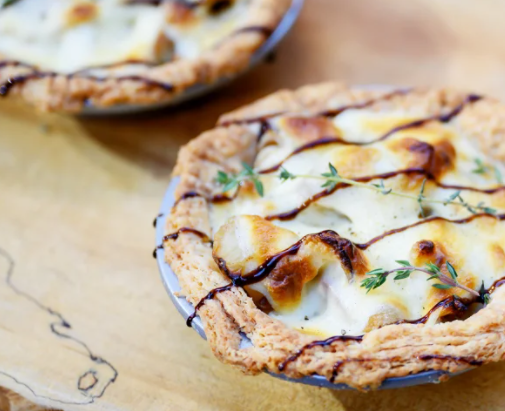
This recipe makes a Torta using caramelized Cipollinis. Torta is a Mexican sandwich which is now also popular in the United States just as Chilaquiles rojos. The recipe is in three parts, namely the dough, the onion filling and the melted cheese.
The ingredients for the onion filling are Cipollinis, olive oil, kosher salt and butter. Although the recipe involves a number of stages, it is worth the effort when the delicious results are considered. View Recipe.
Glazed Cipollini Onions with Rosemary Recipe
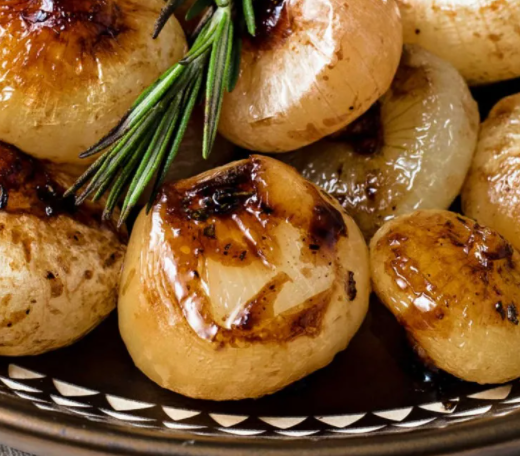
Using this recipe you can produce delicious looking pun glazed little onions which are flavored with rosemary. This is a simple recipe to make, which takes only 30 minutes to complete. The onions will be glazed using a skillet pan (example). If you produce more than you need to use immediately, the glazed Cipollinis can be stored in an airtight container (example) and refrigerated for up to 5 days.
Other ingredients in the recipe are balsamic vinegar, sea salt, freshly ground pepper and unsalted butter among others. On the herbs, thyme could also be used as a substitute to rosemary. View Recipe.
Pickled Cipollini Onions with Chile and Cloves Recipe
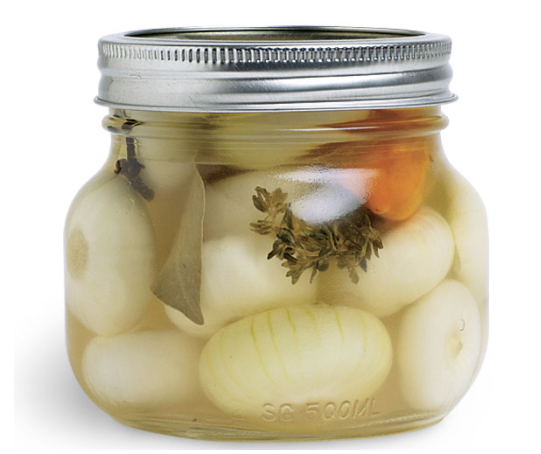
Of a variety of things you could do with Cipollinis that we earlier mentioned, pickling is one of them. This recipe produces tasty pickled little onions. You could use them in salads, as an appetizer topper or stuffing chicken when roasting among other applications.
Needed are good canning jars (example) for the pickling. Ingredients that go into the recipe include bay leaf, garlic, fresh thyme, olive oil and white wine vinegar among others. It appears to us that once you try out this recipe it will be a regular. The results are wonderful. View Recipe.
Cipollini Tian Recipe
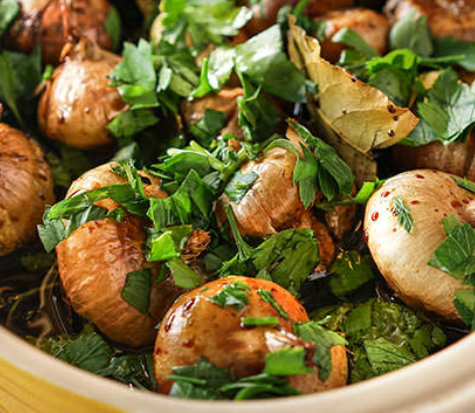
Tian refers to an earthenware cooked layered dish that is browned on top in the oven. This recipe produces such a dish using Cipollini onions. The interesting aspect of this recipe compared to the foregoing recipes above is that the little onions here are cooked with their skins on.
Granted, the onions must be clean for use in the recipe. Other ingredients in the recipe include bay leaves, balsamic vinegar, parsley and black pepper among others. The onions are roasted for at least 1 hour before they are ready to serve. Parsley leaves are used to garnish the dish before serving. View Recipe.
Marsala Cipollini Onions Recipe
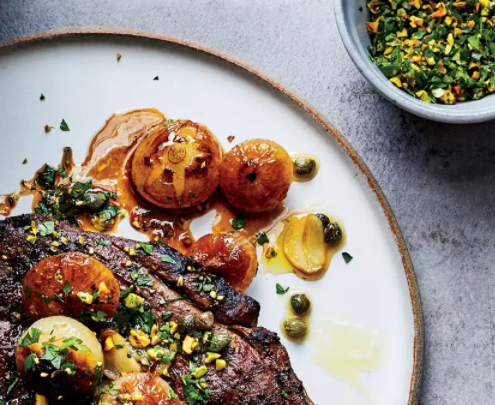
This recipe presents a compelling angle to using Cipollinis. The little onions are caramelized using Marsala wine. Marsala wine is Italian fortified wine. The onions are served as a dressing drizzled over roast, lamb, chicken or beef. The onions are first cooked for a few minutes in a saucepan in grapeseed oil (example).
Other ingredients are added and the onions are further cooked in Marsala before they are further stirred in vinegar. The recipe takes about 45 minutes to complete. View Recipe.
Seared Chicken Thighs Recipe

This recipe produces a complete dish with starch and protein. Ingredients for this recipe include pasta, boneless, skinless chicken thighs, parsley, roasted almonds, balsamic vinegar and Cipollini onions among others.
n this recipe the onions, although small, are not cooked whole, they are sliced up and cooked separately seasoned with salt and pepper for a few minutes until browned and soft. View Recipe.
Growing Cipollini Onions
Cipollinis can successfully be grown in a home garden. For the most part growing Cipollini onions is similar to growing other onion varieties and cultivars. However, there are certain aspects that may be specific to Cipollinis that growers would need to pay some attention to for best results.
Soil for Growing Cipollinis
Italian onions must be raised in well-draining soil which is weed free and that has also been satisfactorily loosened. The soil should be of a pH of between 6.2 and 6.8. In a home garden, Cipollinis can be grown in a raised bed. Mature compost is mixed into the soil. Furthermore, the raised bed is dusted with a cup of balanced fertilizer. This is fertilizer with an equal amount of nitrogen (N), phosphorus (P) and potassium (K) (example).
Seeding the Garden
Cipollini can be directly seeded or started as transplants. Many growers prefer to transplant the onion instead of direct-seeding. Nonetheless, if direct-seeding plant at a 1/4 inch depth and mind a spacing of 2 to 4 inches apart if growing in a single row. If growing in at least two rows, there should be a distance of 24 inches between rows. Germination occurs in about 12 to 14 days, however, cold weather may delay germination.
Thinning of the seedlings will be necessary to maintain the said spacing after germination. Transplants can be started indoors using a a kit (example) and are planted when the green leaves of the onions are 6 to 8 inches tall. In the ground, they are planted using the same spacing as the seeds.
Care and Maintenance of Cipollinis
Cipollinis must be planted in an area that receives full sun most of the day. This sun exposure is consistent with the requirements of other onion types. Bulbing of the onion occurs during the longest days. Furthermore, the onions must be regularly kept moist through irrigation or watering.
Like all onions, Cipollini onion roots are shallow and would quickly feel the impact of any moisture stress. In addition, being 90% water, Cipollinis will need constant water supply in order to turn out juicy as they do. Extra effort should be applied to eradicate any weeds as these easily outcompete Cipollinis due to their shallow roots.
Harvesting Cipollini Onions
When to harvest Cipollini onions is signaled by what happens above ground. As earlier mentioned, Cipollini onions do not bulb above the ground. The most useful cue to their readiness for harvest in addition to variety stated days of maturity are collapsing and dry leaves above the ground. You may also harvest one or two to get a feel of the maturity stage of the rest of them. Damaged Cipollinis go bad quickly due to the exposure of the flesh to air. Those can be utilized right away.
Conclusion
Cipollini onions are small specialty onions with origins in Boretto, Italy. Also known as little onions, Cipollinis are well known for their sweet flavor which becomes more apparent after they are cooked. The onions have a variety of culinary applications and are sometimes used interchangeably with shallots and pearl onions. Although they started off in restaurants, they are now mainstream onions in the United States popular among gardeners also because they are fairly easy to cultivate.
Random But Good Reads:-
- Purple Lettuce Information
- Frisée Lettuce Information
- Cinnamon Basil Information
- Purple Broccoli Information
- Pimento Peppers Information
- Buttercrunch Lettuce Information
- Boston Lettuce Information
- Black Cherry Tomato Information
- Parris Island Lettuce Information
- Murasaki Sweet Potatoes Information
- Pasta Recipes with Shrimp
